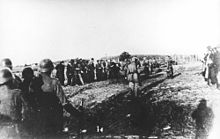| Kragujevac massacre | |
|---|---|
| Part of World War II in Yugoslavia | |
 German troops registering people from Kragujevac and its surrounding areas prior to their execution | |
| Location | Kragujevac, German-occupied territory of Serbia |
| Coordinates | 44°01′17″N 20°53′39″E / 44.02139°N 20.89417°E |
| Date | 21 October 1941 |
| Target | Men and boys of Kragujevac and the surrounding district, mostly Serbs |
Attack type | Mass murder, mass shooting, summary execution |
| Deaths | 2,778–2,794 |
| Perpetrators | Wehrmacht |
| Motive | Reprisal, collective punishment |
The Kragujevac massacre was the mass murder of between 2,778 and 2,794 mostly Serb men and boys in Kragujevac[a] by German soldiers on 21 October 1941. It occurred in the German-occupied territory of Serbia during World War II, and came as a reprisal for insurgent attacks in the Gornji Milanovac district that resulted in the deaths of ten German soldiers and the wounding of 26 others. The number of hostages to be shot was calculated as a ratio of 100 hostages executed for every German soldier killed and 50 hostages executed for every German soldier wounded, a formula devised by Adolf Hitler with the intent of suppressing anti-Nazi resistance in Eastern Europe.
After a punitive operation was conducted in the surrounding villages, during which over 400 males were shot and four villages burned down, another 70 male Jews and communists who had been arrested in Kragujevac were killed. Simultaneously, males between the ages of 16 and 60, including high school students, were assembled by German troops and local collaborators, and the victims were selected from amongst them. The selected males were then marched to fields outside the city, shot with heavy machine guns, and their bodies buried in mass graves. Contemporary German military records indicate that 2,300 hostages were shot. After the war, inflated estimates ranged as high as 7,000 deaths, but German and Serbian scholars have now agreed on the figure of nearly 2,800 killed, including 144 high school students. As well as Serbs, massacre victims included Jews, Romani people, Muslims, Macedonians, Slovenes, and members of other nationalities.
Several senior German military officials were tried and convicted for their involvement in the reprisal shootings at the Nuremberg trials and the Subsequent Nuremberg trials. The massacre had a profound effect on the course of the war in Yugoslavia. It exacerbated tensions between the two guerrilla movements, the communist-led Partisans and the royalist, Serbian nationalist Chetniks, and convinced Chetnik leader Draža Mihailović that further attacks against the Germans would only result in more Serb civilian deaths. The Germans soon found mass executions of Serbs to be ineffectual and counterproductive, as they tended to drive the population into the arms of insurgents. The ratio of 100 executions for one soldier killed and 50 executions for one soldier wounded was reduced by half in February 1943, and removed altogether later in the year. The massacre is commemorated by the October in Kragujevac Memorial Park and the co-located 21 October Museum, and has been the subject of several poems and feature films. The anniversary of the massacre is commemorated annually in Serbia as the Day of Remembrance of the Serbian Victims of World War II.
Cite error: There are <ref group=lower-alpha> tags or {{efn}} templates on this page, but the references will not show without a {{reflist|group=lower-alpha}} template or {{notelist}} template (see the help page).